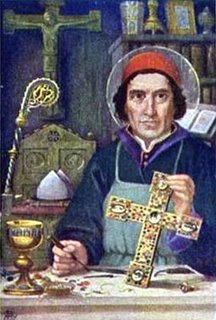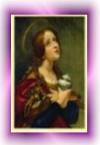Under this master, Bernward made rapid progress in the sciences and in the liberal and even mechanical arts. He became very proficient in mathematics, painting, architecture and particularly. in the manufacture of Sacred Ecclesiastical Vessels and ornaments of silver and gold. He completed his studies at Mainz, where he was Ordained to the Priesthood by Archbishop Willigis, Chancellor of the Empire (975-1011).
Bernward declined a valuable preferment in the Diocese of his uncle, Bishop Volkmar and chose to remain with his grandfather, Athelbero, to comfort him in his old age. Upon the death of the latter, in 987, he became Chaplain at the Imperial Court and, in 987 shortly afterwards, appointed by the Empress-Regent Theophan, as the Tutor to her son, the future Emperor Otto III, then six years of age.
In 993, Bernward was appointed as the Bishop of Hildesheim. His time in office fell during the era of the Saxon Emperors, who had their roots in the area around Hildesheim and were personally related to Bernward. During this time, Hildesheim was a centre of power in the Holy Roman Empire and Bernward was determined to give his City an image fitting for one of its stature.
Bernward ecouraged the arts, commissioned religious paintings and sculpture, refurbished existing Ecclesiastical buildings, built new ones, he built up the Cathedral district with a strong twelve-towered wall and erected further forts in the countryside to protect against attacks by the neighbouring Slavic peoples. Under his direction numerous Churches and other edifices arose, including even fortifications for the defence of his Episcopal City against the invasions of the pagan Normans. He protected his Diocese vigorously from all attacks and consequently his administration was marked by peace. Around 1020, he retired to a Benedictine Monastary to spend his remaining days in prayer.
His life was set down in writing by his mentor, Thangmar, in Vita Bernwardi. He died on 20 November 1022, a few weeks after the Consecration of the magnificent Church of St Michael, which he had built. Beloved Bishop Bernward was Canonized by Pope Celestine III on 8 January 1193.
Church of St. Michael
https://upload.wikimedia.org/wikipedia/ ... esheim.jpg
One of the most famous examples of Bernward’s work ,is a monumental set of cast bronze doors, known as the Bernward Doors, now installed at St. Mary’s Cathedral. The Doors are sculpted with scenes of the Fall of Man and the Salvation of Man – Life of Christ and which are related, in some ways to the wooden doors of Santa Sabina in Rome.
St Bernward’s Doors at St Mary’s Cathedral
https://www.researchgate.net/publicatio ... m_Q320.jpg
Bernward was instrumental in the construction of the early Romanesque St Michael’s Church was completed after Bernward’s death and he is buried in the western crypt. These projects of Bernward’s are today UNESCO World Heritage Sites.
St Michael’s Church has exerted great influence on developments in Architecture. The complex bears exceptional testimony to a civilization that has disappeared. These two edifices and their artistic treasures, give a better overall and more immediate understanding, than any other decoration in Romanesque Churches.
St Michael’s Church was built between 1010 and 1020 on a symmetrical plan with two apses that was characteristic of Ottonian Romanesque art in Old Saxony. Its interior, in particular the wooden ceiling and painted stucco-work, its famous bronze doors and the Bernward bronze column, are – together with the treasures of St Mary’s Cathedral – of exceptional interest as examples of the Romanesque Churches of the Holy Roman Empire.
St Mary’s Cathedral, rebuilt after the fire of 1046, still retains its original Crypt. The nave arrangement, with the familiar alternation of two consecutive columns for every pillar, was modelled after that of St Michael’s but its proportions are more slender.
St Bernward’s Church in Hildesheim, a Neo-Romanesque Church built 1905-07 and St Bernward’s Chapel in Klein Düngen which dates from the 13th Century nad St Bernward’s in Hanover and all dedicated to our Saint.

